“It isn't the mountains ahead to climb that wear you out; it's the pebble in your shoe.” -Muhammad Ali
After a week of travel here at Starts With A Bang -- where we appeared at Balticon 50 and had a fantastic time -- it's time to catch up on all the news that the Universe had to offer. That includes a whole lot, including a fun podcast for Ikonoclast, now live, Saturn just having reached opposition and Mercury, today, at its greatest elongation from the Sun. (Look for it in the pre-dawn sky!) The only Balticon disappointment: the session I had with Larry Niven didn't have audio setup in it, and so I couldn't record a podcast there! (Sorry, but we'll figure something good out.) With that said, here's what the last two weeks have held:
- Why does space appear black? (for Ask Ethan),
- The strongest gravitational show in the Universe (for Mostly Mute Monday),
- Where is new physics hiding, and how can we find it? (a contribution from the always-great Sabine Hossenfelder),
- The Achilles Wheel of the Mars Curiosity rover,
- Black holes as dark matter? Here's where the idea falls apart,
- Why does E = mc^2?,
- How do we know the Earth isn't flat? (for Ask Ethan),
- The double-jet death of Sun-like stars (for Mostly Mute Monday),
- How global warming will someday end life on Earth,
- How does quantum mechanics allow the Sun to shine?,
- Why Mercury isn't the Solar System's hottest planet, and
- NASA's big mistake: LIGO's merging black holes were invisible after all.
With a heat wave sweeping my neck of the woods at the start of this June, let's not dally any longer, and get onto your Comments of the (last two) weeks!
 A diagram of the cosmic distance ladder. Credits: NASA, ESA, A. Feild (STScI), and A. Riess (STScI/JHU).
A diagram of the cosmic distance ladder. Credits: NASA, ESA, A. Feild (STScI), and A. Riess (STScI/JHU).
From Michael Kelsey on the past history of the Universe: "It makes sense to me why H0 is usually taken as one of the constraints, since that’s an observable. The age is something we have to infer from H0 plus the expansion history (or composition)."
Kind of ironic how just a few days after asking his question and me answering, Michael and I both got a surprise when an Adam Riess paper went viral, focusing on the fact that the Universe is expanding faster than expected. Or, more accurately, on the fact that H0 from standard candles appears a few km/s/Mpc higher (at 73, rather than 67-68) than from either the CMB or from BAO. We might report the age of the Universe, for instance, as 13.81 billion years, but if you shift H0 around like that, that number might shift by as much as 300 million years. Always try to keep these systematic errors in mind.
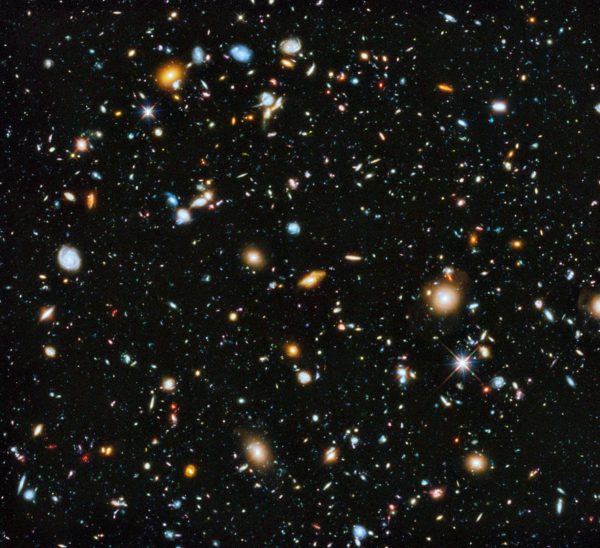 The full UV-visible-IR composite of the XDF; the greatest image ever released of the distant Universe. Image credit: NASA, ESA, H. Teplitz and M. Rafelski (IPAC/Caltech), A. Koekemoer (STScI), R. Windhorst (Arizona State University), and Z. Levay (STScI).
The full UV-visible-IR composite of the XDF; the greatest image ever released of the distant Universe. Image credit: NASA, ESA, H. Teplitz and M. Rafelski (IPAC/Caltech), A. Koekemoer (STScI), R. Windhorst (Arizona State University), and Z. Levay (STScI).
From Dave Grossman on the blackness of space: "The explanation is wrong. There is lots of light coming from the directions that we perceive as dark. The issue is that the light has been so far red-shifted by the expansion of the universe that it’s outside our ability to perceive it."
There are two issues going on here, both of which I attempted to explain at length, but I'll give you the much shorter and to-the-point version here. One is that, in a Universe that began with a Big Bang a finite amount of time ago, the amount of "stuff" that there is to see in any direction is also finite. A finite number of stars, galaxies, etc. Even if we looked at all wavelengths where these objects exist, we wouldn't see light everywhere, because there aren't light sources everywhere.
Unless, that is, you count the light from the radiation of the hot Big Bang itself, which is what the CMB actually is.
Visible with approximately the same intensity and density of photons -- 411/cm^3 -- everywhere we look, this light was once, very early on, high-energy gamma rays. The expanding Universe has redshifted it down into X-rays, UV, visible, infrared, and finally microwave/radio wavelengths, where it resides today. I don't know why you said "this explanation is wrong" since it's exactly the one I gave, but perhaps you can understand it a little better now.
 Six examples of the strong gravitational lenses the Hubble Space Telescope discovered and imaged. Image credit: NASA, ESA, C. Faure (Zentrum für Astronomie, University of Heidelberg) and J.P. Kneib (Laboratoire d’Astrophysique de Marseille).
Six examples of the strong gravitational lenses the Hubble Space Telescope discovered and imaged. Image credit: NASA, ESA, C. Faure (Zentrum für Astronomie, University of Heidelberg) and J.P. Kneib (Laboratoire d’Astrophysique de Marseille).
From Mark Thomas on the weakness of gravity: "What Feynman said about that it is amazing that gravity is weak is correct and very important. Even though we consider gravitation to be strong at the neutron star level or close to a similar mass black hole it is amazingly weak compared to the quantum gravity regime."
These images, of gravitational lenses, show just how strongly the fabric of space can be curved by huge clusters of galaxies. Keep in mind that these lenses typically consist of ~10^12-15 solar masses, or ~10^42-45 kg of matter, or -- another way of looking at it -- around 10^69-72 protons' worth of material. This is a lot of protons, especially when you consider that 10^81 protons is the entire number contained within the visible Universe! And yet, this is what it takes to just observe the subtle effect of gravitational lensing. If you take two protons and compare the electromagnetic force (repulsion, between like charges) and the gravitational force (attraction, between the two masses), you find that the gravitational force is 38 orders of magnitude weaker, or a factor of 100,000,000,000,000,000,000,000,000,000,000,000,000 weaker. It's only because the Universe is electrically neutral and that the other forces are so short range that gravitation matters at all.
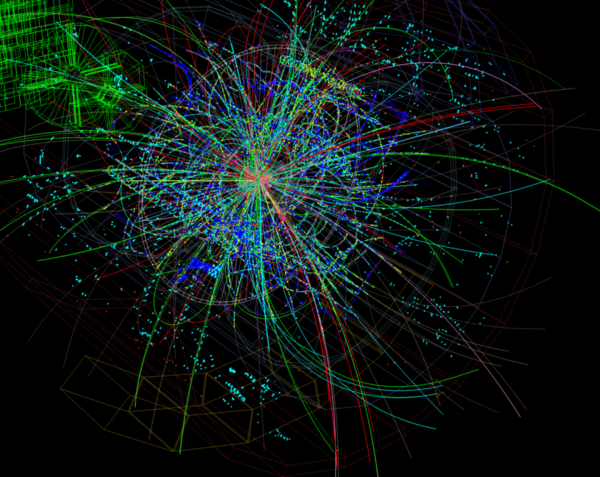 The particle tracks emanating from a high energy collision at the LHC in 2014. Image credit: Wikimedia Commons user Pcharito, under a c.c.a.-by-s.a.-3.0 license.
The particle tracks emanating from a high energy collision at the LHC in 2014. Image credit: Wikimedia Commons user Pcharito, under a c.c.a.-by-s.a.-3.0 license.
From See Noevo pointing out an apparent contradiction between myself and Sabine: "Ethan: “The Standard Model plus General Relativity gives TREMENDOUS SUCCESSES, and has so far accurately described EVERY small-scale, quantum interaction (for the Standard Model) and EVERY gravitational phenomenon (for General Relativity) EVER tested, measured or observed.”
Sabine Hossenfelder: “The Standard Model and General Relativity do a great job, but physicists know this can’t be it. Or at least they think they know: the theories are INCOMPLETE, not only DISAGREEABLE and staring each other in the face without talking, but INADMISSIBLY WRONG, giving rise to PARADOXA with NO KNOWN CURE.”"
And I say in response to you, that both Sabine and I are 100% correct. Yes, there is no known astrophysical or terrestrial gravitational phenomenon nor is there a cosmic ray or collider event that cannot be 100% explained using General Relativity and Quantum Field Theory/the Standard Model. For everything we've ever observed, it is thus far 100% successful. But also, these theories are fundamentally incompatible, and if you ask questions about phenomena we know are real but haven't been able to see -- like what is the gravitational field of an electron as it passes through a double slit? -- we know there must be more to the Universe than these two approximations alone.
So yes, both statements are true: the best theories we have are 100% successful at describing everything we've measured so far, but what we've measured and what the theories predict do not and cannot cover all there is.
Damage to Curiosity’s left-middle wheel, sols 546, 660, and 708. Image credit: NASA / JPL / MAHLI / Emily Lakdawalla.
From Denier on the Curiosity wheel damage: "The biggest fear is actually not in the wheels falling off but rather becoming mostly detached as was the case with the failed wheel being held in the close up shot. The concern is the detached portion of the wheel becomes a serrated sharp edge that will rip into the wiring harnesses running all over the outside of the rover."
I encourage you to read Denier's entire comment, as there's a lot of good information there. The main danger to the wheels in the future is a grouser failure, which would begin to increase the rate-of-damage tremendously. Interestingly, however, the thin aluminum in between the raised treads isn't required at all for the rover to function; so long as the struts and the raised treads remain intact, it can keep on roving and exploring. It will be interesting to see what eventually does Curiosity in, and whether Opportunity winds up outliving it in not only absolute terms, but in continued operations as well?
Left: An infrared view of the sky in Ursa Major. Right: an enhanced view with known sources masked, showing fluctuations of the infrared background. Credits: NASA/JPL-Caltech/A. Kashlinsky (Goddard).
A nice kudos for PBH dark matter from Omega Centauri: "Thanks, I had been wanting to ask about this. You seem to have covered it well."
I had a short conversation about this work with Katie Mack, a scientist I respect tremendously in the same field/sub-field as me. She was the lead scientist on the work that calculated the CMB constraints on primordial black holes. While she freely admitted there were uncertainties in her work -- perhaps a factor of 30% here, perhaps a factor of 2 there -- the total maximum uncertainty was expected to be less than a factor of 10, and yet she would have to be off by 10,000 for the primordial black hole/dark matter scenario to fly. More LIGO detections of black hole-black hole mergers will put that crazy speculation to rest.
The longer a photon's wavelength is, the lower in energy it is. But all photons, regardless of wavelength/energy, move at the same speed: the speed of light. Image credit: NASA/Sonoma State University/Aurore Simonnet.
From Demetris on theorems and symmetry: "Do we have an explanation today in Physics of why the Universe “requires” the conservation laws."
Although there is an informative exchange between Michael and Demetris in the thread (starting here), I wanted to try and answer this at a higher level. The Universe we have contains certain properties: it obeys the laws of General Relativity, on the largest scales it is both homogeneous (the same everywhere) and isotropic (the same in all directions) on average, the particles in it obey the laws of the Standard Model, with the interactions described therein, etc. These laws have associated with them certain symmetries, some of which are true under some circumstances (particles behave the same as their mirror reflections) and some of which are true under all circumstances (particles have the same mean lifetimes as their antiparticles). Each of these symmetries leads to an associated conservation law, as valid as the symmetry itself, by the mathematical theorem (Noether's theorem) that Michael refers to.
 The Standard Model of particle physics. There must be more to nature than this. Image credit: Wikimedia Commons user Latham Boyle, under c.c.a.-by-s.a.-4.0.
The Standard Model of particle physics. There must be more to nature than this. Image credit: Wikimedia Commons user Latham Boyle, under c.c.a.-by-s.a.-4.0.
Interestingly enough, strict energy conservation is not mandated in General Relativity, but the E = mc^2 equivalence for particle masses is a conservation that is mandated. We have the conservation laws we have because the Universe has this particular set of physical laws in it, and if the laws were different, so would some of the conservation (and non-conservation) properties be different as well. Some people speculate that this may, in fact, be the case in other pockets of the Multiverse, or in other regions where symmetries that were restored at high energies broke differently than they did in our Universe.
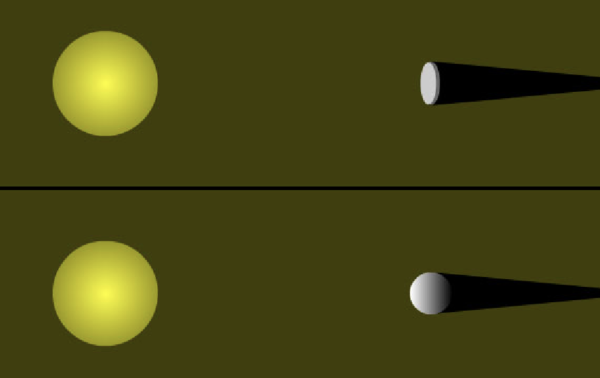 The two ways Earth could cast a circular shadow on the Moon: by being a spherical object (bottom) or a disk-like object (top). Image credit: Windows to the Universe Original (Randy Russell), under a c.c.a.-s.a.-3.0 unported license.
The two ways Earth could cast a circular shadow on the Moon: by being a spherical object (bottom) or a disk-like object (top). Image credit: Windows to the Universe Original (Randy Russell), under a c.c.a.-s.a.-3.0 unported license.
From Wow on the flat Earth theory: "There;s a set of Youtube videos from Youtuber CoolHardLogic on this."
Although CoolHardLogic mostly tests geocentrism rather than the flat Earth hypothesis, the 10-part series on Testing Geocentrism is worth a watch for those of you with some time on your hands.
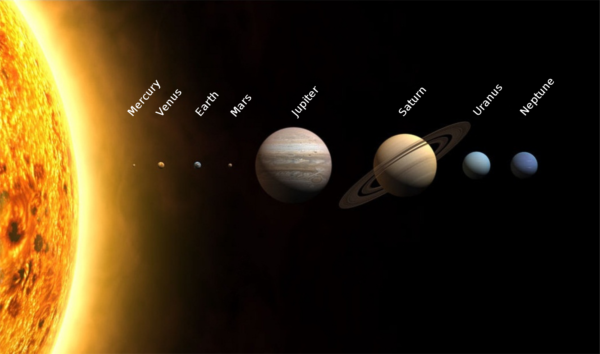 The eight planets of the Solar System. Image credit: Wikimedia Commons user WP, under a c.c.-by-s.a. 3.0 license.
The eight planets of the Solar System. Image credit: Wikimedia Commons user WP, under a c.c.-by-s.a. 3.0 license.
From Denier on changing orbits: "The Moon is constantly moving away from the Earth. It is being accelerated by the tidal bulge of the Earth which leads the Moon because the Earth rotates faster than the Moon. That acceleration moves the moon to ever higher orbits and away from the Earth.
The sun spins faster than the orbit of Earth much like the Earth spins faster than the orbit of its Moon. My question is why doesn’t the rapid rotation of the Sun move the Earth to ever higher orbits and away from the sun?"
This is kind of a tricky question, based on the dynamics of multiple bodies interacting, and there's a lot going on here. The one and only thing you can count on to always be at play in these systems, related to Demetris' assertion from days before, is the law of conservation: in this case, of angular momentum. For the Sun-Earth-Moon system, you must consider it as a whole. In particular,
- the Sun rotates differentially and slowly at the near-perfect barycenter of the system,
- the Earth orbits the Sun, rotating rapidly but with a very long orbital period of revolution,
- and the Moon orbits the Earth, tidally locked to it rotationally.
The net result of this three-body interaction is to cause the Moon to spiral away from Earth and for the Earth's rotation to slow down, mostly due to the Earth's rotation slowing due to tidal friction from the Moon, which I think Denier's comment encapsulated most of. The Sun, however, is a super-perfect sphere. As Kuhn's research has shown most recently, the difference between the polar and equatorial diameters of the Sun is just 10 km, or about 0.0007%, as opposed to Earth's difference, which is 21 km, or about 0.33%. In addition, tidal forces fall off as 1/r^3, so the tidal force of the Sun on the Earth is only 1/3 of the Moon on the Earth, and the Sun has some 300,000 times more inertia.
In other words, what you are saying happens, but it happens so slowly and with such small magnitude that we're not even close to being able to quantitatively measure it.
Hydrogen atom, the building block of nuclear processes in the Sun, in a particular quantum state. Image credit: Wikimedia Commons user Berndthaller, under a c.c.a.-s.a. 4.0 license.
From AC on nuclear binding energy: "What is the mechanism whereby the four nucleons end up being less massive even though we would (based on neutrons being more massive than protons) expect them to be more massive?"
Have you ever brought two powerful magnets close to each other, felt the attraction, and then tried to pull them apart, noting that it takes a substantial amount of force to do so?
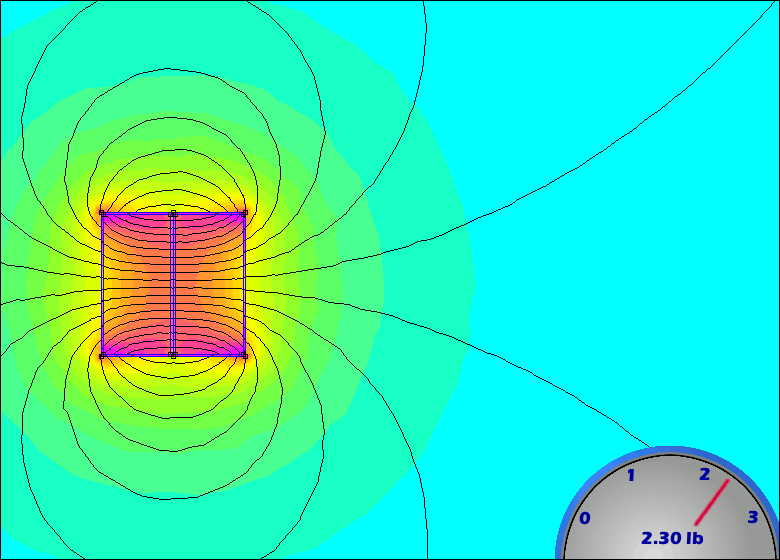 GIF of magnetic attraction, from the Seymour Duncan user group forums user masta' c, via http://www.seymourduncan.com/forum/showthread.php?280394-Double-thick-a….
GIF of magnetic attraction, from the Seymour Duncan user group forums user masta' c, via http://www.seymourduncan.com/forum/showthread.php?280394-Double-thick-a….
That's an example of binding energy, provided by the electromagnetic force. If you had a sensitive enough scale, you'd find that the mass of the bound magnets were slightly less than the mass of the two well-separated magnets, thanks to the fact that binding energy is negative, and that when you have a negative energy, it corresponds to a negative mass; E = mc^2 works for negatives, too!
The strong nuclear force, responsible for this binding, is the strongest force in the Universe, and causes a loss of mass on the order of 1% due to binding energy, whereas the proton-neutron mass difference is only ~0.1%. That's where it comes from!
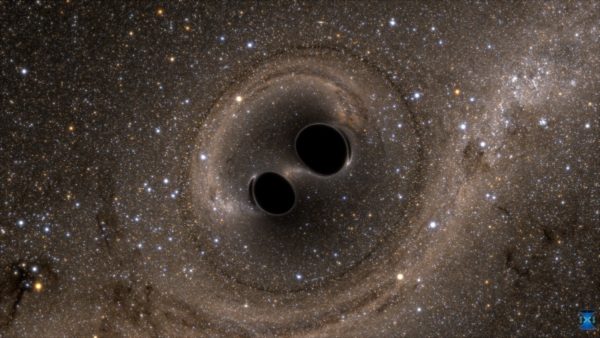 Image Credit: SXS, the Simulating eXtreme Spacetimes (SXS) project (http://www.black-holes.org).
Image Credit: SXS, the Simulating eXtreme Spacetimes (SXS) project (http://www.black-holes.org).
And finally, just to elaborate on what some people allude to on the merging black holes:
- No, the lack of electromagnetic radiation doesn't invalidate the detection of gravitational waves.
- Yes, the lack of electromagnetic radiation -- as found by the ESA's INTEGRAL satellite -- is in line with theory.
- No, flip-flopping the Fermi results isn't a result of P-hacking; the original Fermi results were obtained by applying a method that's useful for high-luminosity signals to a low-luminosity signal, which is not a good method for the latter category.
- And multiple members of the team that wrote this (latest, very good) paper have worked on the Fermi GBM instrument in the past, and would like to see the statistics done properly moving forward.
That's all for the last two weeks, and I'll see you back here soon for even more wonders and joys of the Universe!


I think I agree with Dave Grossman, and don’t think your explanation addresses his point.
…….
........
“… what the CMB actually is… this light was once, very early on, high-energy gamma rays. The EXPANDING UNIVERSE HAS REDSHIFTED IT DOWN into X-rays, UV, visible, infrared, and finally microwave/radio wavelengths, where it resides today.”
This sounds like you’re saying that what appears as X-rays on earth would appear as CMB when viewed from a place a long way from earth. I wonder if that’s right.
…………
..............
“The Universe we have contains certain properties: it obeys the laws of General Relativity, on the largest scales it is both homogeneous (the same everywhere) and isotropic (the same in all directions) on average…”
I like that last bit: “on average.”
It seems about as meaningful as saying
‘U.S. citizen wealth is the same everywhere in the country, on average.’
But tell me, what IS this “largest scale”,
and specifically, WHAT IS THE VANTAGE POINT FROM WHICH ONE SURVEYS THIS SCALE?
It seems to me this vantage point must be from far *outside the universe*, such that even the billion light year-wide Boss Great Wall appears as just another flake in a tiny snow globe in one’s hand.
Oh, dear L-rd, he's outdone himself.
For the theatrical star gazer who sometimes even focuses on end times (e.g. your “How global warming will someday end life on Earth”), time for a Sunday Siesta...
This one’s for you, Ethan:
https://www.youtube.com/watch?v=bETFh4eRdM8
"This is kind of a tricky question, based on the dynamics of multiple bodies interacting"
Multiple *malleable* bodies interacting. Being malleable, it can be cut down to each body being the overall effect of several bodies moving around the CoG of the actual body.
Which rather indicates why it's so bloody awkward.
PS I was pretty sure it was CHL who did a series on flat earth. I don't have access to play YT vids so not entirely able to check up on it. Martymer81 is a very similar personality on YT.
Of course, something like Potholer54's older videos (he's a lot less prolific now) cover things like the creation of the universe as well as climate change.
> This sounds like you’re saying that what appears as X-rays on earth would appear as CMB when viewed from a place a long way from earth.
...
It sounds like you're having difficulty understanding that the *space* those waves travel through is what is expanding. The CMB is (mostly) the result of energy that was emitted at the moment of the creation of the universe. X-rays from Earth would come much later... mostly because Earth didn't exist then, or for a very long time after. Because the universe isn't expanding at that very rapid speed anymore, any new emissions would travel through space that is expanding more slowly... thus any redshifting would also happen much more slowly. X-rays thrown from Earth today would probably still be X-rays a few million years from now to an observer at the required distance.
.
My doubt is regarding Black Hole. As explained in many articles nothing passes through it. Recent finding is that a star swolled by Black Hole. My argument is that any particles ( Star, light or any other matter) coming whithin the gravitationl energy of Black Hole may be pushed to the circumference leading to expansion of the Black Hole. Can any one set right my thinking. ARMS.
Shankar,
You are a bit confused. It is not "passing into the gravitational energy" that prevents escape from a black hole. We are within the gravitational energy of all the black holes in the universe (as well as all other bodies) since gravity has an infinite range. It is rather passing the event horizon that prevents escape. The event horizon distance is equal to the Schwarzschild radius which is equal to 2GM/c^2. For most objects, this radius is a very small value, and the size of the object itself is much greater. For example the sun has a Schwarzschild radius IIRC of about 27 km. Obviously an object cannot approach anywhere near this closely to the sun.
For black holes the situation is different. Black holes are simply objects that are smaller than their Schwarzschild radius. AThis is still very small - a solar mass black hole would have the same Schwarzschild radius as the sun, but for the black hole it is possible to approach to this distance. How small is the black hole? We can't really say because anything approaching closer than the SR cannot exit. Thus, we cannot talk about the real size of a black hole, only its event horizon distance. In fact black holes have only three measurable properties: mass, electric charge, and angular momentum. Nothing else can be measured and these three properties completely define a black hole.
To give a better understanding of black holes consider what would happen if the sun collapsed and became a black hole. Here on earth, other than the "minor" issue of the planet becoming dark and uninhabitably cold, nothing would change. The earth would continue on its orbit just as it has been. This popular notion that black holes are like "cosmic vacuum cleaners" sucking in matter from a large volume of surrounding space is a misconception. Strange things do happen near black holes, but "near" is much closer than most people realize. At large distances black hole gravity is pretty much indistinguishable from the gravity of a non-blak hole object of the same mass.